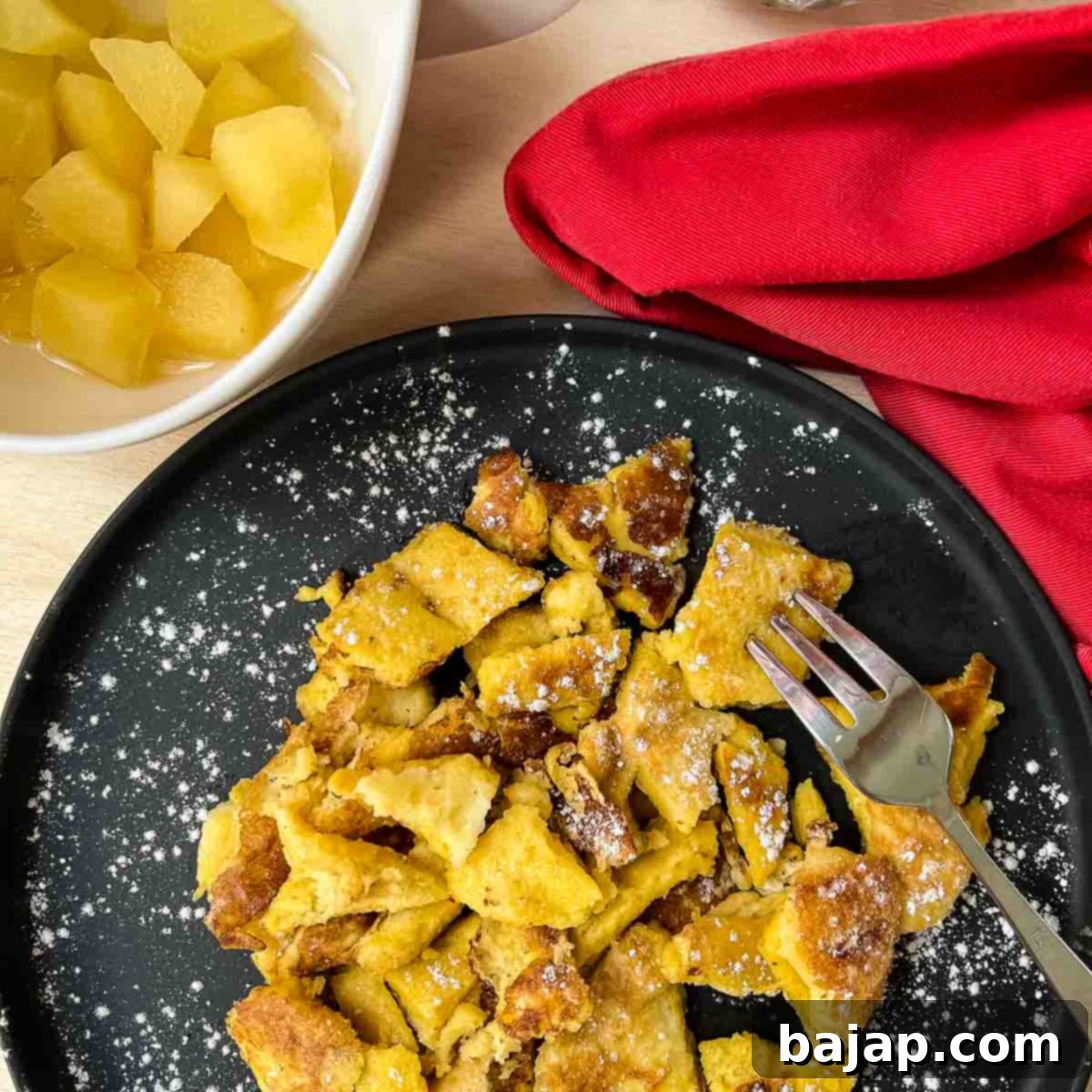Authentic Austrian Kaiserschmarrn Recipe: How to Make Fluffy Shredded Pancakes
Kaiserschmarrn, often affectionately called Emperor’s Mess, scrambled pancakes, shredded pancakes, or torn pancakes, is a beloved Austrian dessert that holds a special place in the hearts of locals and visitors alike. This traditional dish, known for its remarkably light, airy, and sweet pancake-like texture, promises a delightful culinary experience that will truly make your heart beat faster!
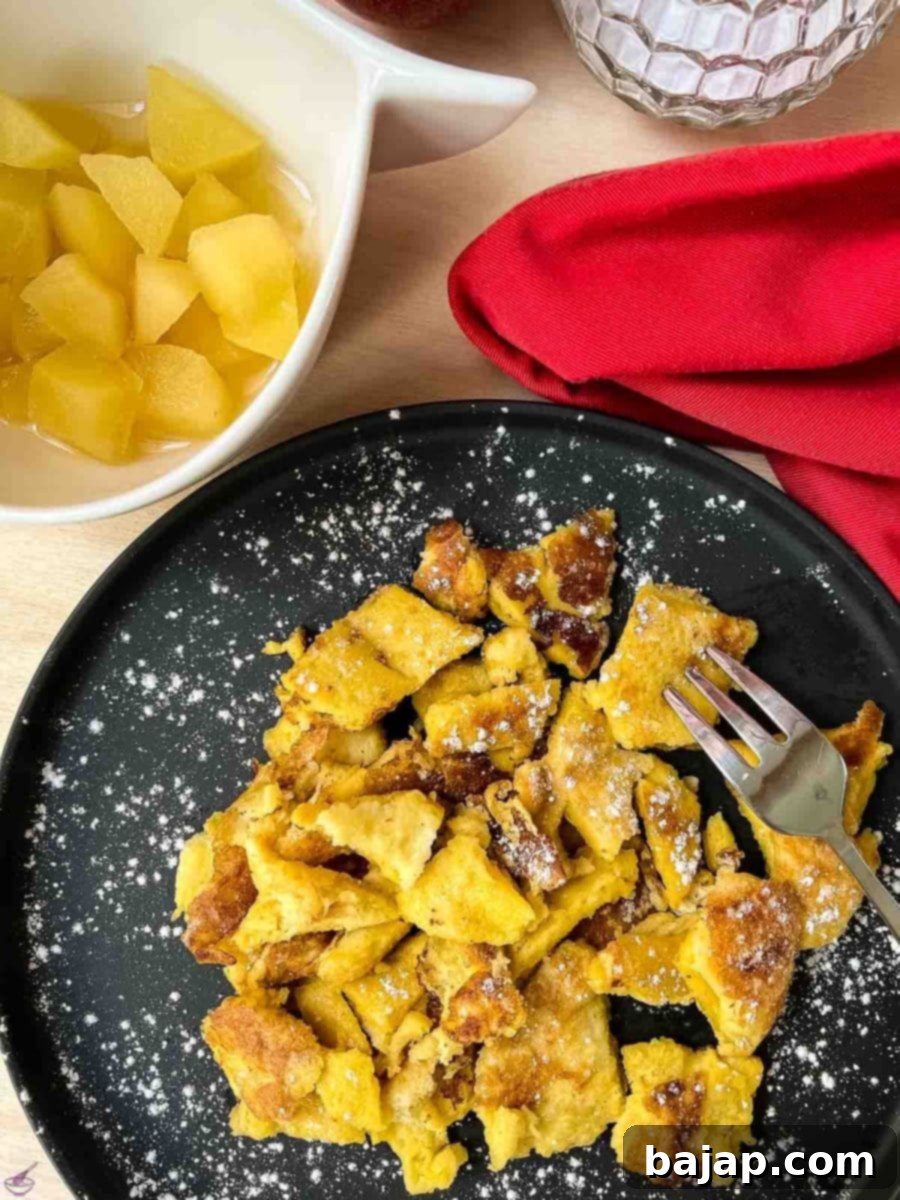
Our easy Kaiserschmarrn recipe allows you to whip up this exquisite treat in under an hour, and it’s designed specifically for those who prefer their shredded pancakes without raisins. However, if you’re a fan of the classic rum-soaked raisins, we’ll guide you on how to easily incorporate them into the thick, fluffy batter. After frying, these golden-brown pancakes are traditionally torn into bite-sized pieces, dusted generously with powdered sugar, and served with a variety of fruit compotes.
Whether you’ve savored this authentic Austrian dish during a visit to the alpine country or are simply curious to try a new sweet sensation, learning how to make homemade Kaiserschmarrn is a rewarding experience. It’s famous not only as a decadent dessert but also as a satisfying sweet main course, perfect for a cozy weekend brunch or a special family meal.
What is Kaiserschmarrn? The Story Behind the Emperor’s Pancake
Kaiserschmarrn, meaning “Emperor’s Mess” or “Emperor’s Scramble,” is a true culinary icon of Austrian cuisine. Legend has it that this delightful dish was a favorite of Emperor Franz Joseph I of Austria, who reigned from 1848 to 1916. The story goes that the Emperor either found his chef’s regular pancakes too plain or, perhaps, the chef accidentally tore a pancake, which was then salvaged and presented as a new dish to the monarch, who loved it. The name “Schmarren” itself is a colloquial Austrian and Bavarian term that can mean a trifle, a mishmash, or a mess, perfectly describing the dish’s delightfully ‘scrambled’ appearance.
Unlike conventional pancakes, Kaiserschmarrn is characterized by its thick, light, and deeply caramelized exterior, achieved by tearing the pancake into pieces while it cooks. The batter is rich and fluffy, often enriched with whipped egg whites, which contribute to its distinctive cloud-like texture. This makes it a truly unique and irresistible sweet dish, enjoyed across Austria, Bavaria, and even in the German-speaking parts of Switzerland.
Why You’ll Love This Easy Kaiserschmarrn Recipe
- Quick & Convenient: This recipe delivers delicious homemade Kaiserschmarrn in under an hour, making it perfect for a spontaneous sweet craving or a quick dessert.
- Irresistibly Fluffy: Thanks to carefully separated and whipped eggs, you’ll achieve an unparalleled fluffy texture that melts in your mouth.
- Customizable: Whether you prefer your Kaiserschmarrn without raisins (as per this base recipe) or with the classic rum-soaked variety, this guide offers flexibility.
- Authentic Austrian Flavor: Experience the true taste of a traditional Austrian dessert, right in your own kitchen.
- Versatile Serving: It pairs beautifully with a range of fruit compotes like roasted plums, apricot compote, or apple compote, allowing for endless delicious combinations.
- Sweet Main Course or Dessert: Enjoy it as a hearty sweet main course for lunch or dinner, or as a decadent dessert to cap off any meal.
Serve your freshly made Kaiserschmarrn traditionally with roasted plums, apricot compote, or apple compote. The combination of the warm, sweet pancake with the tart fruit is simply divine.
[feast_advanced_jump_to]
🥘 Ingredients for the Perfect Kaiserschmarrn
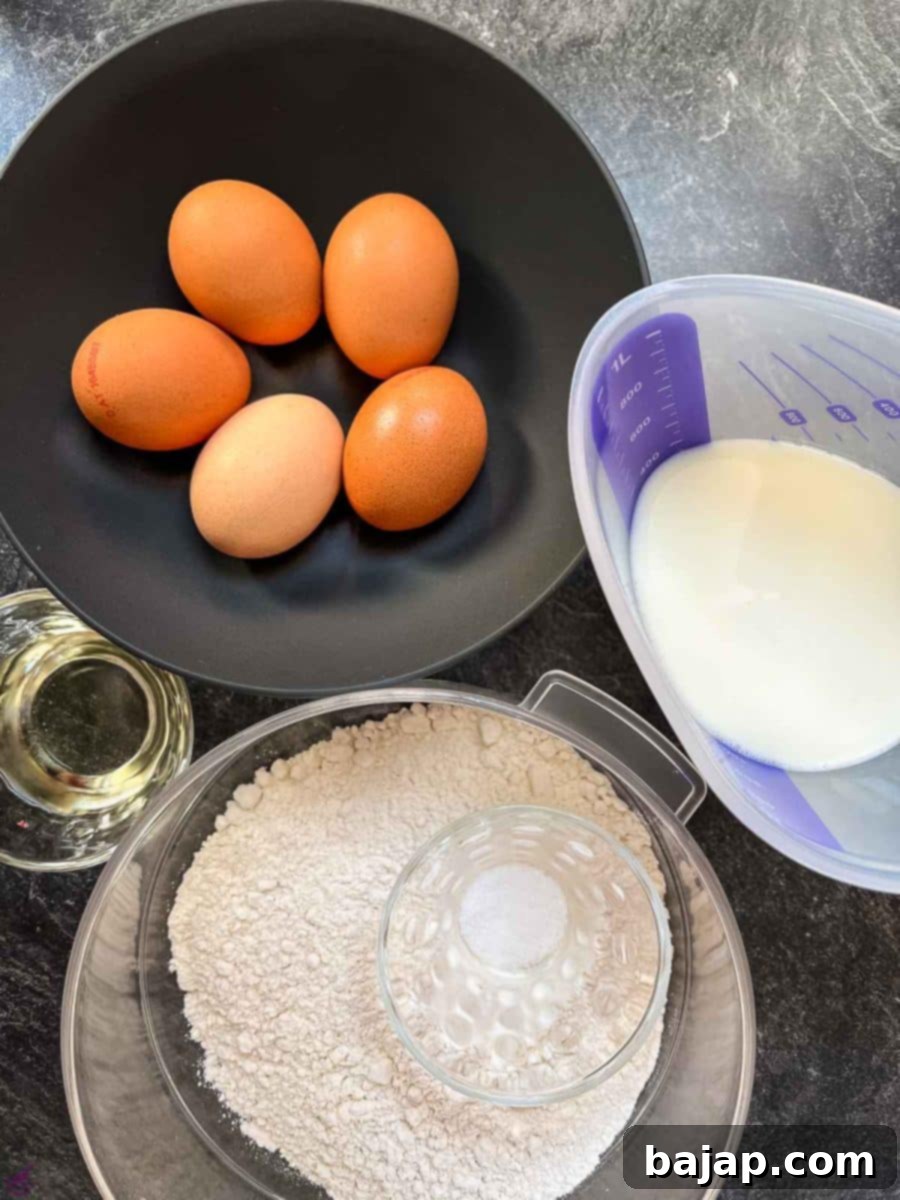
- Unsalted butter or oil: Essential for frying and achieving that rich, golden crust. Butter adds a depth of flavor that oil can’t quite match.
- Eggs – medium-sized: The star ingredient! Separating the yolks and whites is key to the Kaiserschmarrn’s signature fluffiness.
- All-purpose flour: Provides the structure for the pancake batter.
- Milk – whole milk: For a richer, creamier batter. It can easily be substituted with a plant-based alternative if preferred.
- Salt: A small pinch enhances all the sweet flavors.
- Granulated sugar: Sweetens the batter and contributes to the lovely caramelization.
- Powdered sugar – for sprinkling: The classic finishing touch, adding an extra layer of sweetness and a beautiful presentation.
- Optional: Raisins and rum: For a traditional variation, add these to the batter for a deeper flavor profile.
For precise quantities and a complete nutritional breakdown, please refer to the recipe card below.
🔪 Step-by-Step Instructions to Make Fluffy Kaiserschmarrn
Creating authentic Austrian shredded pancakes might seem daunting, but with these clear instructions, you’ll be enjoying your homemade Kaiserschmarrn in no time. The secret lies in the careful separation of eggs and the right frying technique.
Step 1: Prepare the Batter Base
Begin by carefully separating your medium-sized eggs. Place the egg yolks into one large mixing bowl and the egg whites into another separate, clean bowl. Into the bowl with the egg yolks, add the milk (whole milk is recommended for richness, but a plant-based alternative works too), a pinch of salt, and the granulated sugar. Whisk these ingredients together thoroughly until they are well combined and form a smooth, slightly thick mixture. Now, gradually sprinkle in the all-purpose flour, stirring constantly to avoid lumps. Continue stirring until a consistent dough-like batter forms. If you find your batter is too thick, you can adjust its consistency by adding a little more milk, a tablespoon at a time. Conversely, if it seems too thin, incorporate a small amount of extra flour to reach the desired thickness. The batter should be thick but pourable.
Step 2: Fold in the Whipped Egg Whites
This step is crucial for achieving the characteristic fluffiness of Kaiserschmarrn. Using an electric mixer or a food processor, beat the egg whites in their separate bowl until they form stiff peaks. This means that when you lift the beaters, the egg whites stand straight up without collapsing. Gently fold these stiffly beaten egg whites into your prepared yolk-flour mixture. Use a spatula and a light hand, carefully incorporating the air into the batter without deflating it. This delicate folding action is what gives the Kaiserschmarrn its incredibly airy and light texture.
Step 3: Pan-Fry and Shred the Pancake
For the amount of batter this recipe yields, you’ll typically need two large frying pans. Place a tablespoon of unsalted butter or oil in each pan and heat them over medium heat until the butter is melted and sizzling, or the oil is shimmering. It’s important not to overheat the pans; medium heat ensures a golden-brown finish without burning. Evenly pour the fluffy batter into both pans. Let it cook undisturbed until the bottom of the pancake is beautifully golden brown. Once one side is golden, use a spatula to divide each large pancake into quarters directly in the pan, then carefully flip these quarters over to cook the other side.
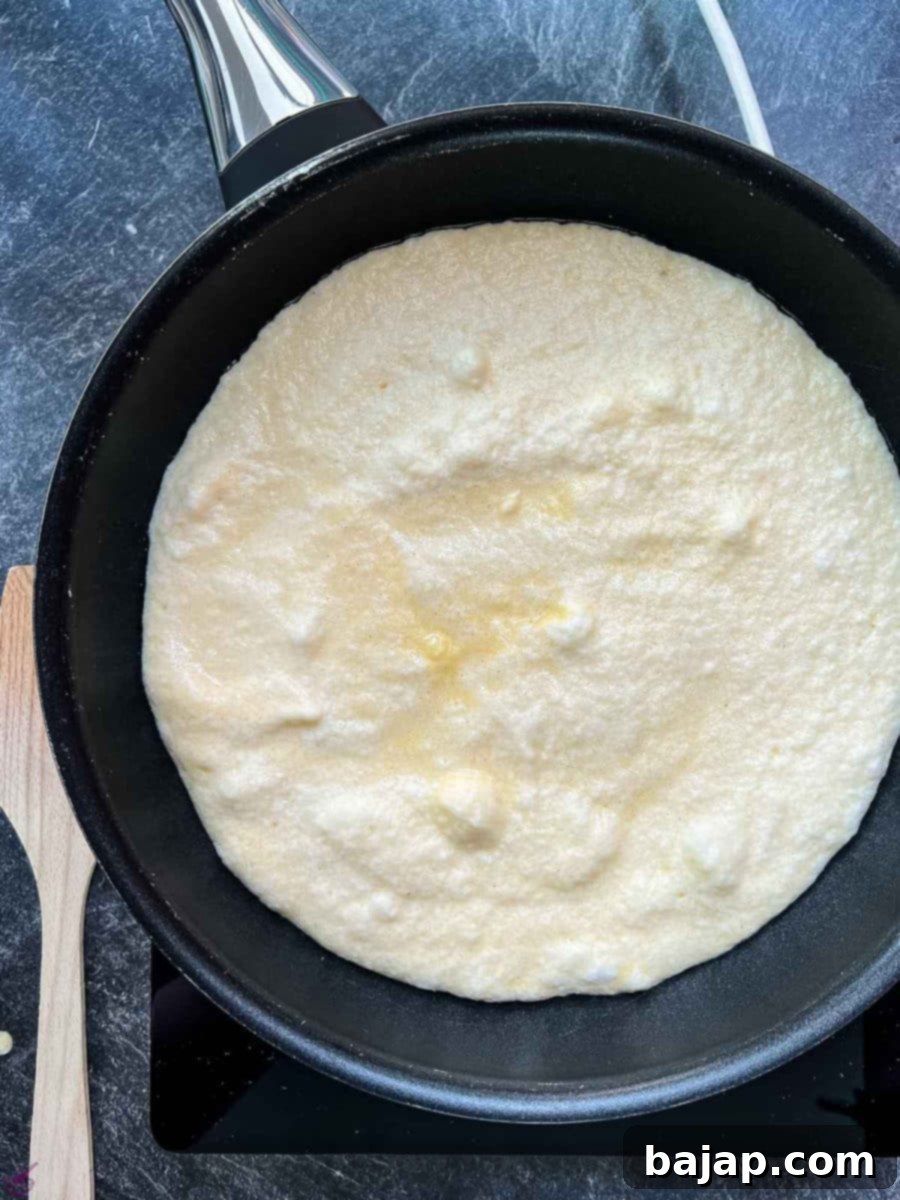
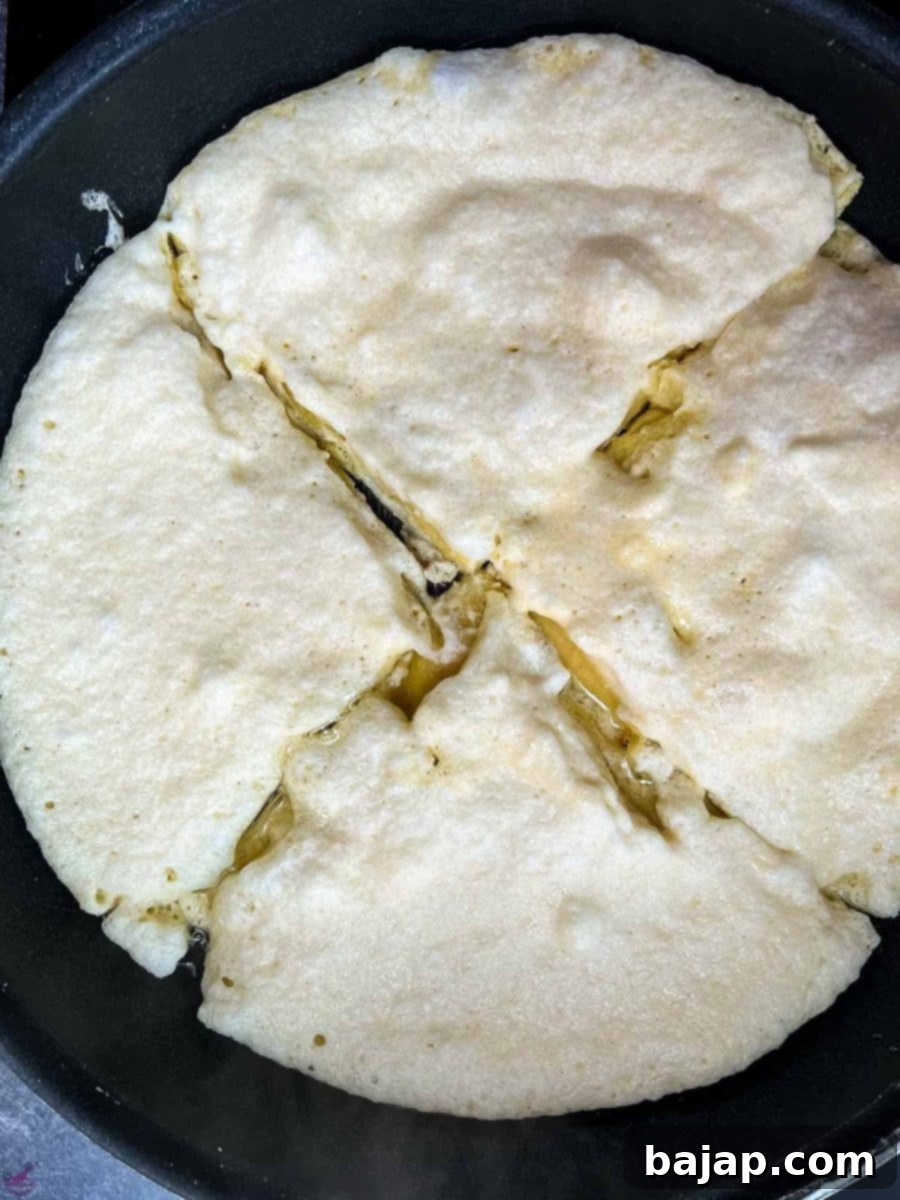
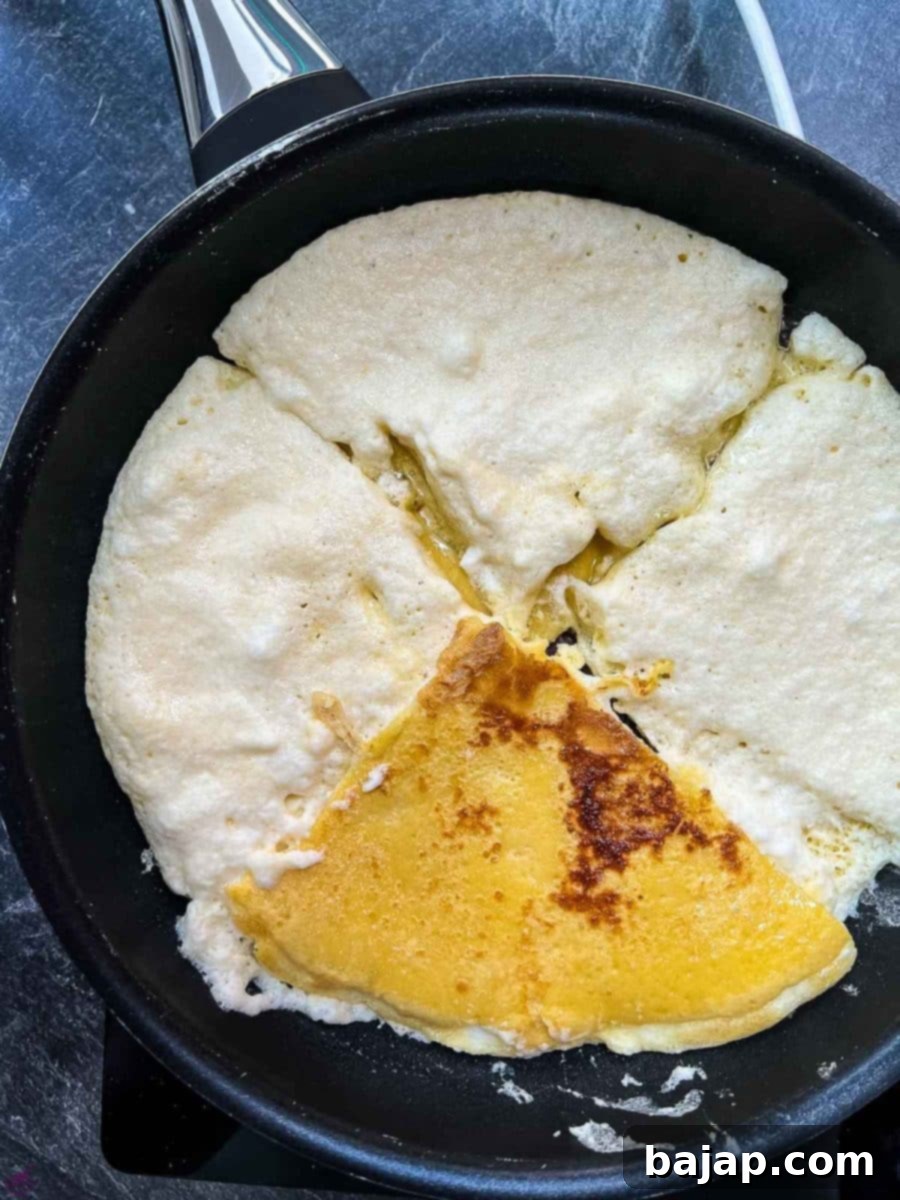
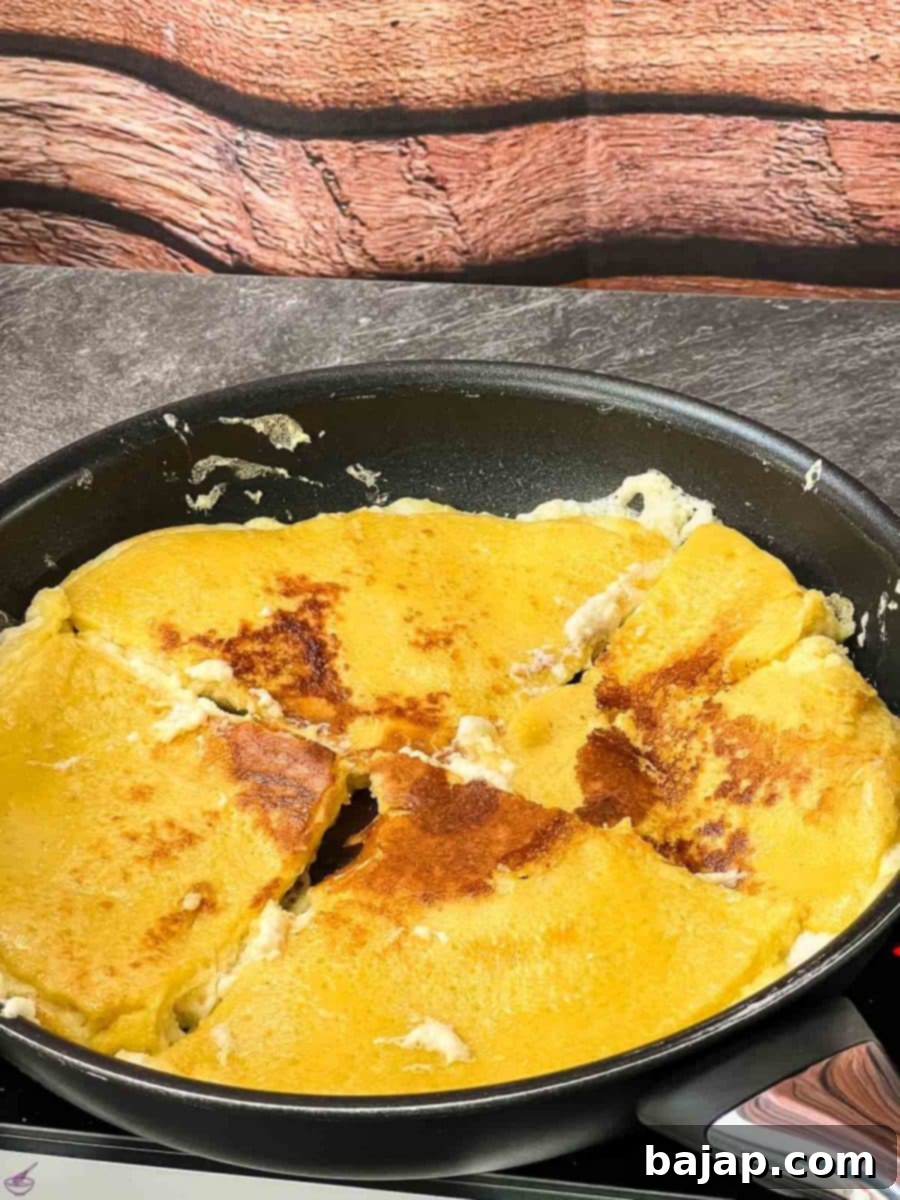
Once the other side of the pancake quarters is golden brown, it’s time to perform the “tear” (Schmarrn)! Using your spatulas, pull the pancake pieces apart into smaller, bite-sized fragments. Continue to fry, gently stirring them around, until all sides of the shredded pancakes are uniformly golden and slightly caramelized. This step is essential for developing the characteristic flavor and texture of Kaiserschmarrn.
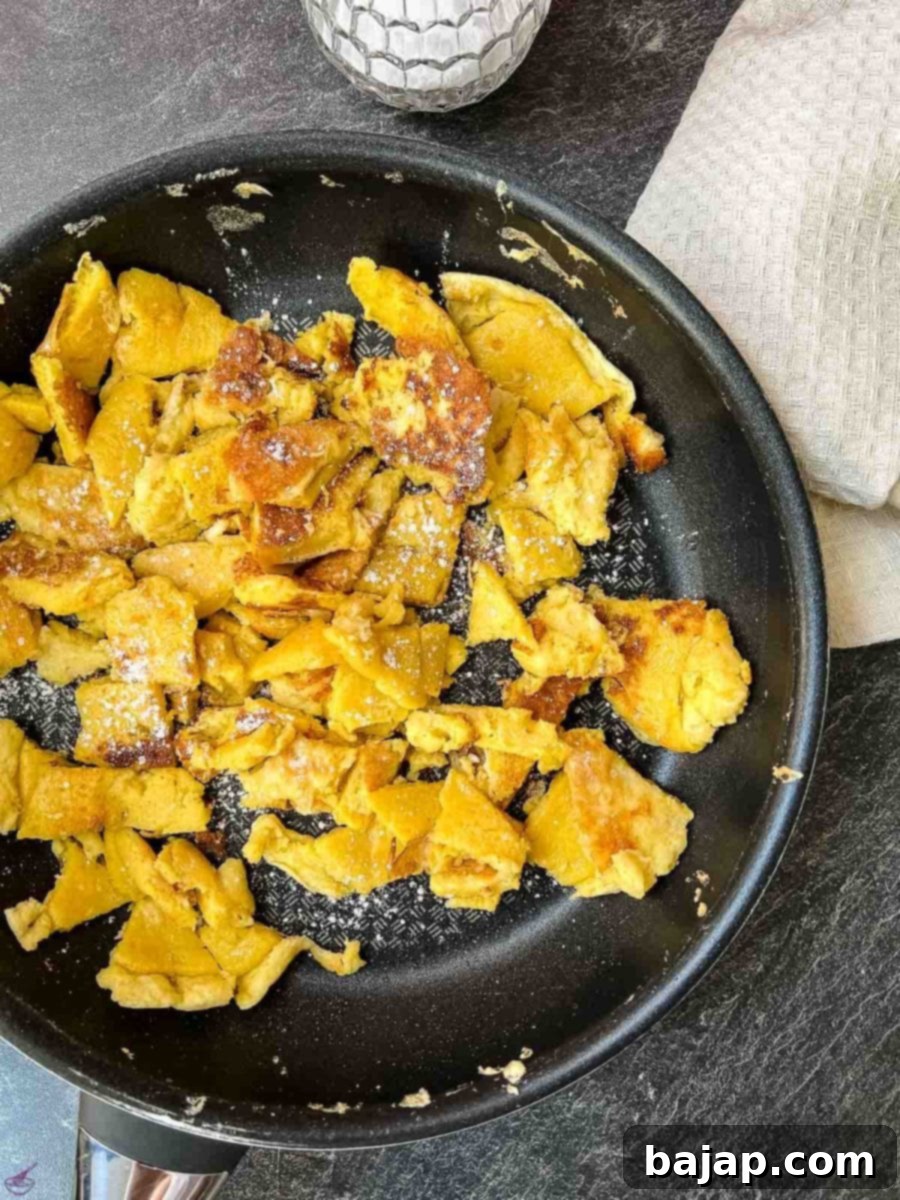
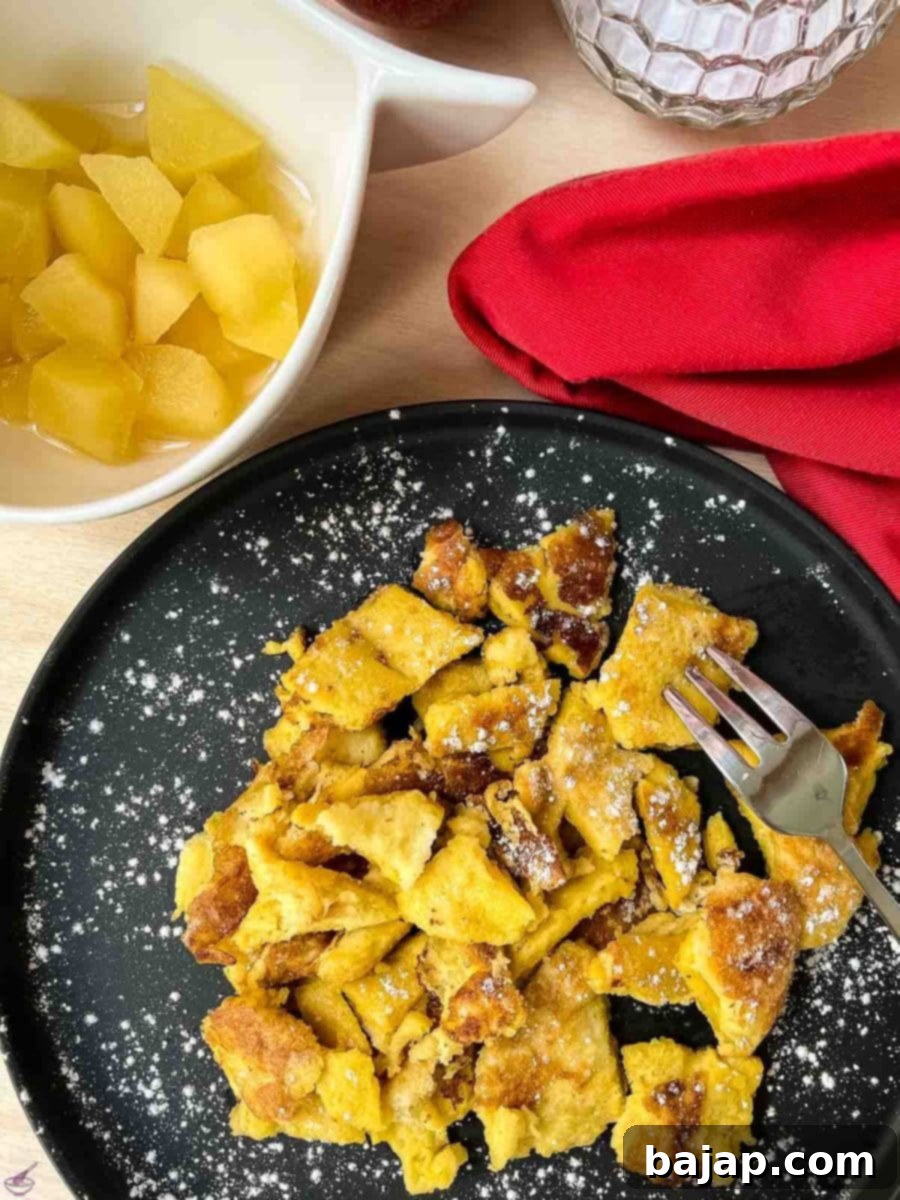
Step 4: Caramelize and Serve
Once your scrambled pancakes are beautifully golden brown on all sides, sprinkle a generous amount of powdered sugar directly over the Kaiserschmarrn in the pan. Continue to cook for another minute or two, allowing the powdered sugar to lightly caramelize, creating a sweet, slightly crispy coating on the pancakes. This adds another layer of delicious flavor and texture. Divide the warm, finished Kaiserschmarrn onto individual plates. For serving, dust with a final flourish of powdered sugar. Traditionally, Kaiserschmarrn is served with a side of apple compote, Zwetschgenröster (roasted plums), or apricot compote. The tartness of the fruit beautifully balances the sweetness of the pancake. Enjoy your traditional Austrian meal!
🇦🇹 Fancy More Traditional Austrian Recipes?
If you’ve fallen in love with the flavors of Austria through this Kaiserschmarrn recipe, you’ll be delighted to explore more traditional Austrian dishes. Here are some fantastic recipes to expand your culinary journey:
- Tafelspitz (Austrian prime boiled beef) – A classic, elegant beef dish.
- Apfelkren (Austrian apple horseradish sauce) – A zesty and flavorful accompaniment.
- Schnittlauchsauce (Chives Sauce) – A fresh, herbaceous sauce perfect for many dishes.
- Erdäpfelschmarrn (Austrian grated pan-fried potatoes) – A savory ‘Schmarrn’ alternative.
- Kandierte Veillchen mit Sekt (Candied violets with sparkling wine) – A unique and sophisticated dessert.
- Liptauer (Liptauer cheese spread) – A spicy and creamy spread, perfect for appetizers.
🍇 Variations: Classic Raisins & More
While our base recipe focuses on a delicious raisin-free Kaiserschmarrn, the traditional version often includes rum-soaked raisins for an extra layer of flavor and texture. If you fancy a more classic “Emperor’s Mess,” here’s how to incorporate them:
- Rum and Raisin Variation: To spice up your emperor’s pancake dough, add a generous shot of rum and about 50-100g (approximately ¼ to ¾ cup) of raisins to the batter. The best time to add these is right before Step 2, after you’ve mixed the egg yolks, milk, salt, sugar, and flour, but before you whip the egg whites and fold them into the batter. This allows the flavors to meld beautifully. You can soak the raisins in rum for an hour or overnight for an even richer taste.
- Lemon Zest or Vanilla Extract: For an added aroma, consider grating a little lemon zest into the yolk mixture or adding a teaspoon of vanilla extract. These subtle additions can enhance the overall sweetness and freshness of the shredded pancakes.
- Different Compotes: Experiment with various fruit compotes! Beyond the traditional apple, apricot, and plum, try berry compotes, cherry compote, or even a simple fresh fruit salad.
🍽 Essential Equipment for Kaiserschmarrn
Having the right tools makes preparing this Austrian delicacy a breeze:
- Two frying pans – ideally with a non-stick coating: Using two pans allows you to cook the entire batch of batter simultaneously, ensuring your Kaiserschmarrn is ready faster and preventing the batter from sitting too long. Non-stick coating is highly recommended for easy flipping and tearing.
- Food processor or electric mixer: Essential for whipping the egg whites to stiff peaks, which is critical for the fluffy texture.
- Two large mixing bowls: One for the yolk mixture and one for the egg whites.
- Two spatulas: Useful for flipping the pancake quarters and, especially, for tearing the cooked pancake into pieces.
🌡 Storage Tips for Leftover Kaiserschmarrn
While Kaiserschmarrn is best enjoyed fresh off the pan, you can certainly store leftovers for later enjoyment:
Refrigerator: Leftover Kaiserschmarrn can be stored in an airtight container in the refrigerator for one to two days. When reheating, gently warm it in a pan over low heat until heated through. You can add a small pat of butter to prevent sticking and help crisp it up again. The fluffiness might reduce slightly, but the taste will still be delightful.
Freezing: Shredded pancakes can also be frozen for longer storage. After frying, allow the Kaiserschmarrn to cool completely (without sprinkling it with powdered sugar). Once cooled, transfer the pieces to a Ziplock bag or an airtight freezer-safe container. Press out as much air as possible before sealing. This way, your delicious Kaiserschmarrn will keep for several months. Keep in mind that freezing and thawing might slightly reduce its famous fluffiness, but it will remain very tasty. To reheat from frozen, you can warm it gently in a pan or even in the oven until warmed through and lightly crisped.
💭 Top Tip for Raisin Lovers (and Haters!)
If you’re making Kaiserschmarrn for a mixed crowd where some love raisins and others don’t, here’s a clever trick: Prepare the base recipe without raisins. Then, for those who adore them (like my daughter!), simply sprinkle raisins over their portion of the finished Kaiserschmarrn just before serving. This way, everyone gets to enjoy this wonderful dish exactly how they like it, ensuring happy eaters all around!
🙋🏻 Frequently Asked Questions About Kaiserschmarrn
The name Kaiserschmarren is a compound word derived from “Kaiser” (Emperor) and “Schmarren” (a colloquial term in Austrian and Bavarian meaning a trifle, mishmash, or mess). The most popular legend attributes its creation to Emperor Franz Joseph I, either as a dish he particularly enjoyed or as a ‘scrambled’ pancake his chef presented after an accidental tearing. The word “Schmarren” is thought to be related to the German words “scharren” (to scrape) and “schmieren” (to smear), referring to the way the pancake is torn and mixed during cooking.
Course: Wikipedia
Kaiserschmarrn is unequivocally Austrian in origin and is considered one of its national dishes. However, its popularity extends beyond Austria. You can also find variations of Kaiserschmarrn enjoyed in Germany, particularly in Bavaria, as well as in the German-speaking regions of Switzerland, Hungary, and Slovenia, reflecting the historical reach of the Austro-Hungarian Empire.
Traditionally, Kaiserschmarrn is served with a variety of fruit compotes or sauces. The most common accompaniments include stewed plums (Zwetschgenröster), apple compote or applesauce, and apricot compote. Other popular choices include cherry compote or fresh berries. A dusting of powdered sugar is always a must, and sometimes a scoop of vanilla ice cream or a dollop of whipped cream can also be added for an extra decadent touch.
Not at all! While it might look impressive, Kaiserschmarrn is surprisingly simple to prepare. The key steps are separating eggs, whipping the whites, gently folding them in, and then pan-frying until golden and tearing it apart. With our clear, step-by-step instructions, even beginner cooks can achieve perfect, fluffy shredded pancakes.
The main difference lies in preparation and texture. Regular pancakes are typically thinner, round, and cooked until done, often served stacked. Kaiserschmarrn uses a much thicker batter, often with separated and whipped eggs for extreme fluffiness. It’s cooked as a thick pancake, then torn into irregular pieces while still in the pan, resulting in a “scrambled” or “shredded” appearance. This tearing process also creates more caramelized edges, adding to its unique flavor and texture. It’s usually served dusted with powdered sugar and with fruit compotes.
If you make this authentic Austrian Kaiserschmarrn recipe, please let me know how you liked it by giving it a ★★★★★ star rating and leaving a comment below. Your feedback is truly awesome! You can also sign up for our Newsletter or follow me on Pinterest or Instagram and share your creation with me. Just tag me @combinegoodflavors and hashtag #combinegoodflavors, so I don’t miss it.
📖 Recipe: Fluffy Austrian Kaiserschmarrn – Torn Pancakes
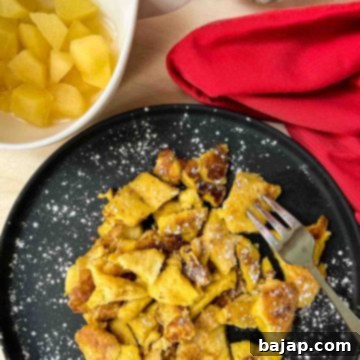
Austrian Kaiserschmarrn – torn pancakes
Nora
Prevent your screen from going dark
Save Recipe
Saved!
Pin Recipe
20 minutes
20 minutes
40 minutes
Dessert, Main Course
Austrian
4
Servings
318
kcal
Equipment
-
2 Pans
-
Food processor
or electric mixer -
2 Large mixing bowls
-
2 Spatulas
Ingredients
- 2 teaspoons Unsalted butter or oil
- 5 Eggs
- 1 ½ cups All purpose flour
- 1 ½ cups milk
- 1 Pinch Salt
- 1 teaspoon Sugar
- Powdered sugar for sprinkling
Optional
- Raisins ¼ – ¾ cup (and a shot of rum)
Instructions
-
Carefully separate the 5 medium-sized Eggs into two large mixing bowls.5 Eggs
-
In the mixing bowl with the egg yolks, add 1 ½ cups whole milk, 1 Pinch Salt, and 1 teaspoon Granulated Sugar. Whisk until well combined.5 Eggs,
1 ½ cups milk,
1 Pinch Salt,
1 teaspoon Sugar -
Gradually sprinkle in 1 ½ cups All-purpose flour, stirring constantly until a smooth batter forms. Adjust consistency with milk or flour if needed.1 ½ cups All purpose flour
-
Now, beat the egg whites in the separate bowl until they form stiff peaks. Gently fold them into the yolk-flour mixture with a spatula.
-
Place two large frying pans over medium heat. Add 1 teaspoon Unsalted butter or oil to each pan and let it get hot.2 teaspoon Unsalted butter
-
Divide the batter evenly between the two pans and fry over medium heat. Do not turn the heat too high to prevent burning.
-
Once the bottom is golden brown, divide each pancake into quarters using a spatula and flip them over to cook the other side.
-
Continue frying until the other side is golden brown. Then, use your spatulas to tear the pancakes into small, bite-sized pieces.
-
Stir the scrambled pancakes a few more times in the pan to ensure all pieces are golden brown and lightly caramelized.
-
Sprinkle some Powdered sugar over the Kaiserschmarrn in the pan and allow it to caramelize for a minute. If desired, add Raisins (soaked in rum for a traditional touch) directly to the pan at this stage, mixing them in.Powdered sugar,
Raisins -
Divide the finished Kaiserschmarrn onto plates. Dust generously with additional powdered sugar and serve immediately with your favorite fruit compote, such as apple compote, roasted plums (Zwetschgenröster), or apricot compote. Enjoy!
Never miss a recipe!
Sign up and let me spoil you weekly with a delicious homemade recipe!
Austrian torn pancakes, Erdäpfelschmarrn, Kaiserschmarrn, pancakes, shredded pancakes, torn pancakes
Like this recipe?
Mention @combinegoodflavors or tag #combinegoodflavors!
Nutrition values are estimates only, using online calculators. Please verify using your own data.
Serving:
1
Serving
|
Calories:
318
kcal
|
Carbohydrates:
40
g
|
Protein:
15
g
|
Fat:
11
g
|
Saturated Fat:
5
g
|
Polyunsaturated Fat:
1
g
|
Monounsaturated Fat:
3
g
|
Trans Fat:
0.1
g
|
Cholesterol:
221
mg
|
Sodium:
123
mg
|
Potassium:
260
mg
|
Fiber:
1
g
|
Sugar:
6
g
|
Vitamin A:
506
IU
|
Calcium:
149
mg
|
Iron:
3
mg

🇦🇹 You Might Also Like These Austrian-Inspired Delights!
- How to make an Apple Compote
- Vanilla Bean Ice Cream Pancakes {Palatschinken}
- Best way to make Iced Coffee
- Delicious Elderflower Fritters {Air Fryer}
⛑️ Food Safety Guidelines for Home Cooking
Ensuring food safety is paramount when preparing any meal. Please follow these essential guidelines to keep your kitchen and food preparation safe and hygienic:
- Thorough Cooking: Always cook eggs and any other ingredients to a minimum internal temperature of 165 °F (74 °C) to eliminate harmful bacteria.
- Prevent Cross-Contamination: Never use the same utensils or cutting boards on cooked food that have previously touched raw ingredients, especially raw meat or eggs. Always wash them thoroughly between uses.
- Hand Washing: Wash your hands thoroughly with soap and warm water before and after handling raw ingredients, and after touching anything that might be contaminated.
- Temperature Control: Do not leave perishable food, including batter or cooked Kaiserschmarrn, sitting out at room temperature for extended periods (typically no more than two hours) to prevent bacterial growth.
- Never Leave Cooking Unattended: Always keep an eye on food cooking on the stovetop or in the oven to prevent burning or accidents.
- Choose High Smoke Point Oils: When frying, use oils with a high smoke point (like canola oil, grapeseed oil, or refined sunflower oil) to avoid burning and the production of harmful compounds. Butter can be used, but watch it carefully as it burns more easily.
- Ensure Good Ventilation: Always use good ventilation, such as an extractor fan or open windows, when using a gas stove or frying to disperse cooking fumes.
For more comprehensive food safety information and best practices, please consult the official guidelines from reputable sources like the Safe Food Handling – FDA.
